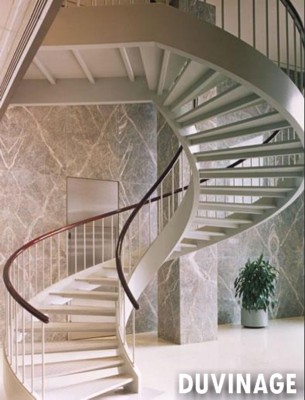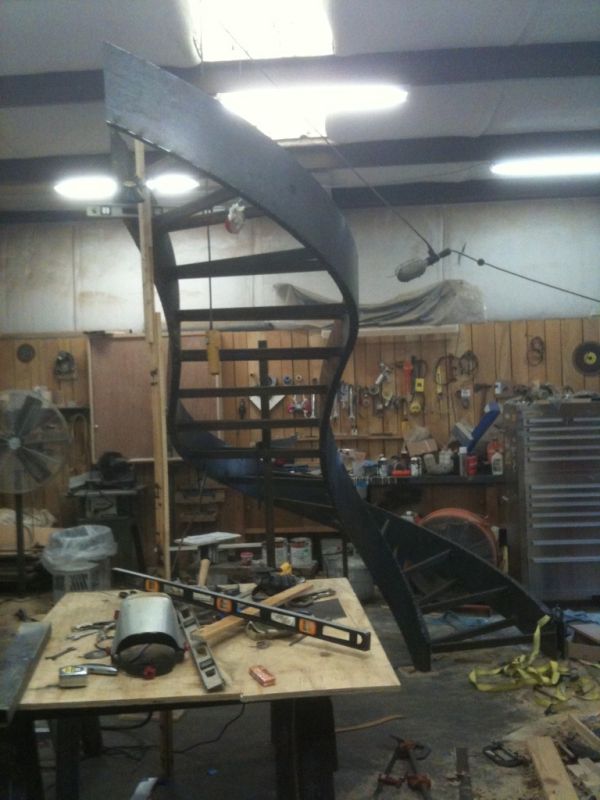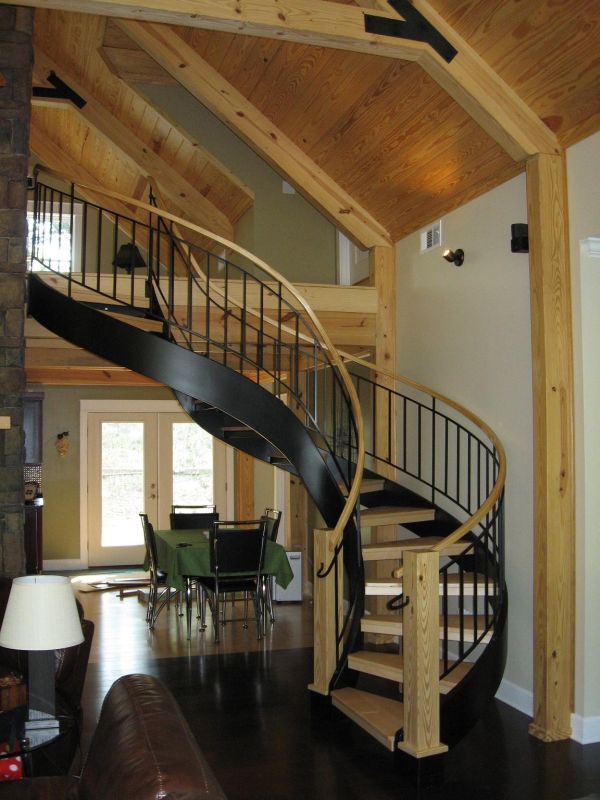Question
I'm building a curved staircase where the main structure is steel, and the handrails, tread, and newel posts will be wood. The picture below shows the project. It's basically a 180 turn, two transition steps, and a 90 turn opposite.
The radius of the curves are about 1' on the inside rail and 4' on the outside rail. I constructed the balusters and handrail supports by simply measuring vertically to a 32" handrail height. Here comes the issue.
When you uniformly raise the handrail a certain vertical height above the side rails, the rail on the smaller radiused curve appears shorter because the vertical angle is greater. It's the same height at the same point as the larger outside rail, but I guess there is an optical illusion that makes it appear shorter.
Is there anything that can be done to cheat a little to make it appear more uniform?


Forum Responses
(Architectural Woodworking Forum)
From contributor L:
Call it part of the charm, mystery, etc!
As long as the rail height is the same at every stair nose, inside or outside, then the rail is right and the eye will adapt to it. Try to monkey with it and it will not look correct.
However, it appears that you will have changes in pitch in your rail vs. the rail in the picture. The one in the picture is a continuous radius, and therefore the same pitch/run for each tread. It appears that the run of your treads varies from tread to tread - where the treads are the outer radius, the rail will be less pitch with a longer run, but then the same rail goes to a greater pitch as the subsequent treads become inside and a shorter run.
Consider an adjustable trapezoid with the space between the rail and the stringer being the trapezoid. You can see that the inside trapezoid is raked much farther forward, which then shortens the perpendicular distance between the raked, parallel lines.
Of course there's nothing to be done about this except raise the height of the inside rail. While this has sometimes been recommended, generally it's not a good idea to have differing handrail heights.
It's funny, but as the inside rail height may look shorter, when you actually walk up the stair, it definitely feels much higher. That's because the reach of your arm (which hasn't changed) is now extending farther up the steeper rail. The opposite is true as you descend the stair with the inside now feeling uncomfortably low. People, however, usually descend a stairway along the outside and ascend up the shorter inside curve.
These are all normal considerations for double-helix stairs, being part of their charm and beauty, but your serpentine stair is quite another kettle of fish. Serpentine stairs are one of those things that look impressive in plan-view but when constructed, rarely result in anything satisfactory or pleasing to the eye. In fact serpentine stairs can be confusing to the mind's eye as your brain struggles to put some form to an irregular and ever changing shape.
The worst set of stairs I've ever seen (bar none) involved a pair of free-standing serpentine stairs which faced each other and were topped and surrounded with an irregular curved balcony. The enclosing walls were also covered in mirrors. The free-flowing elegance which the architect had (somehow) envisioned turned into a dizzying fun-house complete with roller-coaster stair. I would say that the slight illusion of different handrail heights in a typical double-helix stair is the very least of your optical illusions to worry about here.
